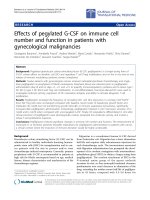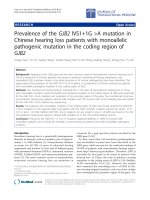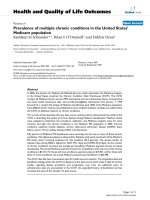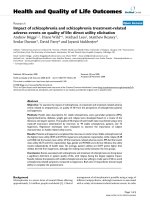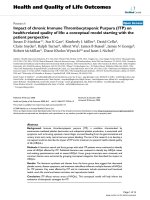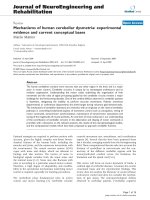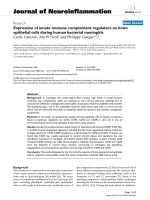Báo cáo hóa học: " Elicitation of protective immune responses using a bivalent H5N1 VLP vaccine" pot
Bạn đang xem bản rút gọn của tài liệu. Xem và tải ngay bản đầy đủ của tài liệu tại đây (329.64 KB, 9 trang )
BioMed Central
Page 1 of 9
(page number not for citation purposes)
Virology Journal
Open Access
Research
Elicitation of protective immune responses using a bivalent H5N1
VLP vaccine
Corey J Crevar
1
and Ted M Ross*
1,2
Address:
1
Center for Vaccine Research, University of Pittsburgh, Pittsburgh, PA, USA and
2
Department of Microbiology and Molecular Genetics,
University of Pittsburgh, Pittsburgh, PA, USA
Email: Corey J Crevar - ; Ted M Ross* -
* Corresponding author
Abstract
Background: Currently licensed human vaccines are subtype-specific and do not protect against
pandemic H5N1 viruses. Previously, our group has reported on the construction of an influenza
virus-like particle (VLP) as a new generation candidate vaccine. A mixture of influenza H5N1 VLPs
representing clade 1 and 2 viruses were examined for the ability to elicit protective immunity
against isolates from various clades and subclades of H5N1.
Results: Mice were vaccinated intramuscularly with each VLP individually, the mixture of VLPs, a
mixture of purified recombinant hemagglutinin (rHA), or mock vaccinated. Elicited antibodies were
assayed for the hemagglutination-inhibition (HAI) activity against clades 1 and clade 2 isolates. Mice
vaccinated with each VLP individually or in a mixture had robust HAI responses against homologous
viruses and HAI responses against the clade 2.3 virus, Anh/05. However, these vaccines did not
induce an HAI response against the clade 2.2 virus, WS/05. Interestingly, clade 2 VLP vaccinated
mice were protected against both clade 1 and 2 H5/PR8 viruses, but clade 1 VLP vaccinated mice
were only protected against the clade 1 virus. Mice vaccinated with a mixture of VLPs were
protected against both clade 1 and 2 viruses. In contrast, mice vaccinated with a mixture of rHA
survived challenge, but lost ~15% of original weight by days 5–7 post-challenge.
Conclusion: These results demonstrate that a multivalent influenza VLP vaccine representing
different genetic clades is a promising strategy to elicit protective immunity against isolates from
emerging clades and subclades of H5N1.
Introduction
Since re-emerging in 2003, avian influenza viruses of the
H5N1 subtype have spread from Southeast Asia across
central Asia and the Middle East into Europe and Africa by
infecting wild birds and poultry. New influenza viruses
and genotypes are emerging each year and are leading to
significant genetic variation among H5N1 viruses [1].
Currently, 10 clades of H5N1 isolates have been identified
in birds. Recent human isolates have clustered into two
distinct clades, clade 1 and clade 2, with clade 2 further
being divided into subclades 2.1, 2.2, and 2.3. Although
H5N1 remains an avian virus, not yet adapted to efficient
transmission between humans, there is concern that small
genetic changes may significantly alter the pandemic
potential of this virus, allowing it to emerge as the next
influenza pandemic strain. Therefore, a potential vaccine
Published: 28 October 2008
Virology Journal 2008, 5:131 doi:10.1186/1743-422X-5-131
Received: 17 August 2008
Accepted: 28 October 2008
This article is available from: />© 2008 Crevar and Ross; licensee BioMed Central Ltd.
This is an Open Access article distributed under the terms of the Creative Commons Attribution License ( />),
which permits unrestricted use, distribution, and reproduction in any medium, provided the original work is properly cited.
Virology Journal 2008, 5:131 />Page 2 of 9
(page number not for citation purposes)
against H5N1 influenza isolates should ideally protect
against the diverse set of currently circulating strains and
future H5N1 variants.
One of the challenges faced by influenza vaccine develop-
ers is the ability to protect populations in the face of
emerging and spreading pandemics. The next influenza
pandemic may be caused by an H5N1 virus and if so, it is
not known which clade or subclade may be responsible.
Therefore, vaccine(s) that elicit broadly-reactive immune
responses against viruses from multiple or all H5N1
clades are critical targets for vaccine manufacturers. Previ-
ously, our group described the development and immu-
nogenicity elicited by a recombinant H5N1 influenza
virus-like particle (VLP) vaccine in mice and ferret models
[2-4]. This VLP vaccine does not require the use of any live
influenza virus in the manufacturing process that would
significantly complicate the safety and process of mass
production. VLP-based vaccines are a promising, innova-
tive technology for safe and efficacious vaccines against
many viral diseases [5-10], including influenza viruses
[4]. VLP vaccines are particularly advantageous to meet
future global pandemics because these vaccines 1) need
short lead times for development of "new-to-the-world"
vaccines, 2) use recombinant DNA technology to facilitate
rapid strain matching, 3) provide the correct three-dimen-
sional antigenic conformation of the HA and NA for
"native-like" presentation of antigens to the immune sys-
tem, and 4) show promise in being able to induce a robust
and broadly reactive immunity against drifted virus vari-
ants at low doses without the addition of an adjuvant [2-
4,11].
Conventional seasonal influenza vaccines use a trivalent
mixture of split viruses, containing two influenza A sub-
types (H1N1 and H3N2) and one variant of influenza B
virus without the loss of immunogenicity to an individual
subtype within the vaccine formulation. Therefore, we
speculated that mixing influenza H5N1 VLPs could be a
promising strategy to elicit protective immunity against
various clades and subclades of H5N1. A multivalent pan-
demic influenza VLP vaccine has not been investigated
despite the need to evaluate alternative influenza vaccine
strategies that elicit immune responses against viral iso-
lates from different clades. In this study, two H5N1 VLPs
representing clade 1 and clade 2 isolates were mixed
together to generate a bivalent vaccine formulation. The
mixed VLP vaccine was administered to mice and the pro-
tective immune responses were compared to each individ-
ual VLP vaccine, rHA, and a mock control.
Results
Induction of antibodies following VLP immunizations
Previously, our group has demonstrated the effectiveness
of influenza virus-like particles to elicit immune
responses against HA, NA, and M1 from clade 1 and clade
2 H5N1 isolates [2]. In this study, clade 1 and clade 2
H5N1 VLPs were formulated in a mixture prior to admin-
istration to mice to determine if there was a loss of immu-
nogenicity compared to each VLP administered
individually. Recombinant baculoviruses expressed indi-
vidual HA, NA, or M1 proteins from A/Viet Nam/1203/
2004 (clade 1) or the A/Indonesia/05/2005 (clade 2)
viruses. These proteins assembled into viral particles, were
efficiently secreted into the supernatant, and were puri-
fied, as previously described [2-4]. Mice (BALB/c; n = 8)
were vaccinated (week 0 and 3) via intramuscular injec-
tion with each individual influenza VLP or VLPs were
mixed in an equal ratio (1:1) based upon HA content.
Purified rHAs were used as a positive control. At week 5,
mice vaccinated with VLPs individually or in a mixture
had similar serum IgG endpoint dilution titers (~1:10
5
) to
the clade 2 rHA (Figure. 1). In contrast, mice vaccinated
with the mixture of VLPs had a log lower anti-HA titer
(1:10
4
) to the clade 1 rHA compared to mice administered
each VLP individually (1:10
5
). IgG
2a
was the dominate
isotype (data not shown).
Serum samples were evaluated for the ability to prevent
virus-induced agglutination of horse RBCs. At week 5,
100% of the mice vaccinated with clade 2 VLP (201 +/-
834 GMT) to the homologous clade 2 Indo/05 virus (Fig-
ure. 2A and 2C). Mice with an HAI value ≥ 1:40 were con-
sidered positive. One clade 2 VLP vaccinated mouse
consistently had higher HAI titers, regardless of the virus
tested (Figure. 2A). Mice vaccinated with clade 2 VLPs did
not have any cross-reactive HAI antibodies to VN/04 (Fig-
Antibodies elicited by vaccinationFigure 1
Antibodies elicited by vaccination. Mice (n = 8) were
vaccinated via intramuscular injection at weeks 0 and 3 with
VLPs (clade 1 or clade 2) or recombinant HA, or PBS only
(Mock). At week 5, serum from each group was pooled and
tested for anti-HA antibodies by ELISA. The endpoint dilu-
tion titer was determined against Indo/05 rHA or VN/04
rHA. Pre-immune sera from mice had no detectable specific
anti-HA antibodies.
100
1000
10000
100000
Anti-HA Antibody
Coating Antigen
Indo/05 rHA VN/04 rHA
1000000
Clade 2 VLP
Clade 1/Clade 2 VLP
Clade 1 VLP
Clade 1/Clade 2 rHA
Mock
Virology Journal 2008, 5:131 />Page 3 of 9
(page number not for citation purposes)
ure. 2A), however, all mice vaccinated with 1/clade 2 VLPs
had HAI titers against VN/04 (Figure. 2B). All the mice
vaccinated with the clade 1 VLP had HAI activity against
the clade 1 VN/04 virus and 50% of the clade 1 VLP vacci-
nated mice had HAI antibody titers against the clade 2.1
Indo/05 virus (Figure. 2C). As predicted, all mice vacci-
nated with the mixture of clade 1/clade 2 VLPs elicited
HAI antibodies against the both VN/04 virus (115 +/- 36
Hemaggutination-inhibition (HAI) titersFigure 2
Hemaggutination-inhibition (HAI) titers. Week 5 serum HAI antibody responses were assessed against H5N1 clade 1
(VN/04) and clade 2 (Indo/05, WS/05, Anh/05) viruses. Bars indicate geometric mean titer (GMT) +/- 95% CI. A) Clade 2 VLP;
B) Clade 1/Clade 2 VLPs; C) Clade 1 VLP; D) Clade 1/Clade 2 rHA; E) Mock. * indicates p < 0.05 compared to Clade 1 VLPs.
Clade 1 VLP
I
n
d/0
5
W
S/0
5
An
h
ui
/05
V
N
/04
8
16
32
64
128
256
512
1024
2048
4096
Vir us
HAI (GMT; Log
2
)
Clade 2 VLP
I
nd
/
05
W
S/05
Anhui/05
VN/04
8
16
32
64
128
256
512
1024
2048
4096
Virus
HAI (GMT Log
2
)
Clade 1/Clade 2 rHA
In
d
/
0
5
W
S
/
0
5
Anh
u
i/05
VN/04
8
16
32
64
128
256
512
1024
2048
4096
Virus
HAI (GMT; Log
2
)
Clade 1/Clade 2 VLP
Ind/05
WS/05
Anh
u
i
/
0
5
VN/04
8
16
32
64
128
256
512
1024
2048
4096
Virus
HAI (GMT; Log
2
)
Mock
I
nd/05
W
S/05
A
n
h
u
i
/
05
V
N
/04
8
16
32
64
128
256
512
1024
2048
4096
Vir us
HAI (GMT; Log
2
)
*
Virology Journal 2008, 5:131 />Page 4 of 9
(page number not for citation purposes)
GMT) and Indo/05 virus (80 +/- 0 GMT) (Figure. 2B).
Only 33% of the mice vaccinated with a mixture of clade
1/clade 2 rHA had an HAI titer (36 +/- 12 GMT) against
the Indo/05 virus (Figure. 2D).
VLP elicited antibodies were also tested against viruses
from other clade 2 subclades. All the mice vaccinated with
the clade 2 VLPs had HAI activity against the clade 2.3
Anhui virus (Figure 2A), however there was lower HAI
activity against the clade 2.2 WS/05 (Figure. 2A) or BGH/
05 (data not shown) viruses. All mice vaccinated with the
clade 1 VLPs had HAI titers against Anh/05 and only 1 of
the 8 mice (12.5%) had HAI activity against WS/05 (Fig-
ure. 2C). Similar results were observed in mice vaccinated
with the mixture of clade 1/clade 2 VLPs.
Influenza virus challenge
Mice were challenged with H5/PR8 reassortant viruses
representing either the clade 1 VN/04 virus or the clade 2
Indo/05 virus. Mice were observed for clinical signs of
infection (ruffled fur, dyspenea, lethargy) and weight loss.
Unvaccinated mice that were challenged with either virus
lost ≥ 20% of original body weight by day 6 post-infection
(Figure. 3). Mice vaccinated with the clade 1, clade 2, or a
mixture of clade 1/clade 2 VLPs and then challenged with
the clade 1 VN/04 virus had no weight loss (Figure. 3A)
and had no clinical signs of infection over the period of
observation (Table 1). Mice vaccinated with the mixture
of rHA proteins lost ~15% of their original body weight by
day 6 and then began to recover.
In contrast to clade 1 virus challenge, mice vaccinated
with clade 1 VLPs and then challenged with the clade 2
Indo/05 virus were not protected from challenge (Figure.
3B). All these mice showed signs of disease (Table 1), lost
≥ 20% of their original weight, and died by day 6 post-
challenge. Mice vaccinated with clade 2 VLPs or the mix-
ture of clade 1/clade 2 VLPs were all protected from clade
2 Indo virus challenge. Similar to clade 1 virus challenge,
mice vaccinated with a mixture of clade 1/clade 2 rHA
proteins lost ~15% of their body weight, but the weight
loss was more gradual with the peak weight loss at day 7.
These mice recovered more quickly than mice challenged
with clade 1 virus.
On day 3 post-challenge with Indo/05, the lungs of 5 mice
from each group were collected and tittered for virus
(Table 1). Mice vaccinated with the clade 2 VLPs or a mix-
ture of clade 1/clade 2 VLPs had low viral titers following
challenge with the clade 2 Indo virus. Whereas, mice vac-
cinated with clade 1 VLPs or a mixture of clade 1/clade 2
rHA proteins had viral titers similar to unvaccinated mice
(Table 1).
Discussion
A new influenza pandemic is inevitable. The culprit could
be an avian influenza strain from the H5N1 subtype. To
date, many vaccine candidates have been developed
against avian H5N1 influenza viruses, some traditional
and some novel. It is clear that to respond to an emerging
threat posed by an avian influenza outbreak, a vaccine
must be immunogenic and be able to induce immunity,
against potential viral drift variants. In addition, recom-
binant-based vaccine options need to permit the ability to
quickly adapt a vaccine to match the circulating strain of
virus and then manufacture the relevant vaccine in a short
period of time. Alternatively, a vaccine must elicit a
broadly reactive immune response that neutralizes viruses
from various clades of H5N1 influenza.
In this study, we investigated the ability of a vaccine rep-
resenting isolates from clade 1 and clade 2 of the H5N1
subtype of influenza to elicit protective antibodies against
viruses from both clades. The clade 1 and clade 2 VLPs
were immunogenic in mice and protected against virus
challenge, regardless if the VLP vaccines were adminis-
tered individually or in a bivalent formulation. The clade
2 VLP elicited a high degree of cross-protection than the
clade 1 VLP (Figure. 3).
The cross-reactivity of the single-strain vaccines is more
limited than that of the mixed vaccine. A mixture of these
VLPs elicited HAI antibodies that inhibited the agglutina-
tion of horse RBCs by both the clade 1 and clade 2 isolates
that were homologous to the vaccines (Table 1). These tit-
ers were statistically similar to the titers elicited by each
VLP vaccine alone. As expected, there were no cross-clade
reactive HAI antibodies elicited by each VLP vaccine
administered individually. Antibodies elicited by clade 1
or clade 2 viruses have limited cross-reactive HAI activity.
Multivalent spilt vaccines consisting of an H1N1, H3N2
and B are commonly administered each year to people for
seasonal influenza viruses [12]. The results presented in
this report indicate that a bivalent or multivalent vaccine
based upon emerging strains with high pandemic poten-
tial should be considered for further evaluation in clinical
trials. A low dose, multivalent vaccine, without an adju-
vant, may be appropriate for stock-piling or for pre-pan-
demic immunization of high risk individuals.
In order to examine the breadth of HAI activity against
clade 2 isolates from different subclades, antisera was
tested against viral isolates representing clades 2.2 and
2.3. The clade 2 VLP vaccine was derived from a clade 2.1
isolate and we have previously demonstrated no cross-
reactive HAI activity to clade 2.2 viruses, but elicited anti-
bodies do show some level of HAI cross-reactivity to some
clade 2.3 isolates (personal observations). We chose to
examine the cross-reactivity to viruses within clade 2, and
Virology Journal 2008, 5:131 />Page 5 of 9
(page number not for citation purposes)
not clade 1 or 3, since the most recent reports indicate that
isolates from the clade 2 lineage are spreading to Europe,
Middle East and Africa. Mixing clade 1 and clade 2 VLPs
did not increase HAI activity against the clade 2.2 isolate
WS/05 (Table 1) or BGH/05 (data not shown). Interest-
ingly, these antibodies maintained HAI activity to the
clade 2.3 virus (Anh/05), however, the average HAI GMT
titer was lower than the HAI titer elicited by the clade 2
Influenza virus challengeFigure 3
Influenza virus challenge. At week 5, mock vaccinated mice or mice vaccinated with vaccines were challenged intranasally
with reassortant H5/PR8 influenza viruses representing (A) VN/04 or (B) Indo/05. Mice were monitored daily for weight loss,
activity, and survival. Body weight is plotted as percentage of the average initial weight. Mice that lost greater than 30% body
weight were sacrificed.
'D\V3RVW&KDOOHQJH
%RG\:HLJKW
$,QGRQHVLDFODGH
'D\V3RVW&KDOOHQJH
%RG\:HLJKW
$9LHWQDPFODGH
$
%
&ODGH9/3
&ODGH&ODGH9/3
&ODGH9/3
&ODGH&ODGHU+$
0RFN
&ODGH9/3
&ODGH&ODGH9/3
&ODGH9/3
&ODGH&ODGHU+$
0RFN
Virology Journal 2008, 5:131 />Page 6 of 9
(page number not for citation purposes)
VLP alone (Figure. 2). These results are highly significant
and demonstrate that a multivalent vaccine against H5N1
appears to be a plausible strategy to combat the diversity
of clades and subclades of H5N1 influenza. Future studies
will need to determine the efficacy and breadth of immu-
nity elicited by a multivalent vaccine composed of VLPs
representing various clades or subclades of H5N1.
There was a direct correlation to survival of mice to lethal
challenge and the level of HAI activity elicited by the vac-
cines. Recent studies in ferrets have shown that HAI anti-
body titers raised against vaccine candidates from avian
H5N1 influenza viruses do not always correlate with pro-
tection against a lethal challenge virus [3,11,13-15]. These
differences in protection against lethal challenge between
mice and ferret may be due to the differences in the anat-
omy of these two species and the site of viral replication.
Influenza replicates in the nasal and upper respiratory
tract in ferrets, however, the bolus of virus delivered to the
mouse is delivered into the lower respiratory tract thereby
resulting in different pathogenicity.
The isotype of the antibody may play as an important a
role in protection as the antibody titer. Whether mixed
together or individually, these VLPs elicited an IgG
2a
anti-
body profile (data not shown). Previous studies from our
group in mice indicated that these VLPs elicited high titer
serum IgG
2a
following intramuscular injection [2,3]. The
IgG
2a
isotype has been associated with protection against
influenza, even in the absence of neutralizing antibodies
[16] and appears pivotal in anti-viral immunity [17].
Intramuscular vaccination of rHA elicited a mixed IgG
1
/
IgG
2a
isotype response. IgG
2a
correlates with increased
viral clearance and enhanced protection against chal-
lenge, whereas IgG
1
secretion is more often associated
with binding ELISA assays and microneutralization assays
[16]. IgG
2a
is the most effective isotype at fixing comple-
ment [18] and binding to Fc receptors on macrophages
[19,20] and NK cells [20]. Enhanced antibody uptake by
these cells increases opsonization and antibody-depend-
ent mediated cytotoxicity (ADCC) [21], as well as clear-
ance of influenza in the respiratory mucosa [22].
Therefore, one of the advantages of these VLP vaccines
may be enhanced viral clearance, independent of HAI or
neutralization activity.
In addition to humoral responses, VLP vaccines have been
shown to elicit cellular immunity [2] and therefore, we
cannot rule out that cellular immune responses elicited by
these vaccines played a role in the protection. Protection
against influenza infection is a multifactorial phenome-
non, with both innate and cellular responses (NK, NKT,
and CD8+ T cell responses) associated with clearance of
influenza viral infected cells [23]. The role of innate and
adaptive cellular responses to influenza vaccination has
not been extensively studied in humans. Even fewer stud-
ies have addressed the role of vaccine-induced cellular
responses to influenza virus on the outcome of infection,
particularly in neonates and the elderly. We recently
showed that these VLP vaccines could elicit T cell specific
HA and M1 responses [2,3] and reduced the induction of
pro-inflammatory cytokines and granulocytes into the
lungs following either intramuscular or intranasal VLP
vaccination.
The recombinant influenza virus-like particle vaccines
preserve native, conformational antigenic epitopes of
influenza proteins in the context of a highly immuno-
genic, non-infectious structure. VLPs elicit immune
responses and protection at low doses (HA content) and
without the use of an exogenous adjuvant [2], both of
which potentially reduce reactogenicity of the vaccine.
Recombinant VLP vaccines avoid the potential safety risks
associated with live attenuated or whole virus pandemic
influenza vaccines, because the manufacturing process
does not require infectious virus.
Conclusion
Each season, manufactures generate seasonal influenza
vaccines based on a mixture of three viruses representing
Table 1: Virological and pathological assessment following Indo/05 challenge
Vaccine
a
% Body Weight
b
% Body Weight
c
Plaque Titer
d
Activity
e
Dyspnea
f
Clade 2 VLP 102% 103% <1.00e+2 0 0
Clade 1/Clade 2 VLP 102% 101% 5.25e+3 0 0
Clade 1 VLP 95% 76% 5.73e+6 2 1
Clade 1/Clade 2 rHA 98% 89% 3.54e+5 1 0
Mock 94% 77% 5.94e+6 2 1
a
Vaccine administered at weeks 0 and 3.
b
Percentage of original weight at day 3 post-challenge.
c
Percentage of original weight at day 6 post-challenge.
d
Particle forming units (pfu) per milliliter (ml) in the lungs of mice at day 3 post-challenge.
< 1.00e + 2 = Viral titers less than 100 pfu/ml.
e
Activity score. 0 = Full activity, 1 = slow to respond to touch, but still mobile, 2 = little response to touch.
f
Dyspnea. 0 = no shortness of breadth. 1 = heavy breathing and shortness of breadth.
Virology Journal 2008, 5:131 />Page 7 of 9
(page number not for citation purposes)
a H1N1, H3N2, and a B influenza virus. Therefore, we
speculated that a multivalent vaccine representing strains
from different clades of H5N1 influenza could elicit pro-
tective immunity. Two H5N1 virus-like particle vaccines
representing clade 1 and clade 2 isolates were mixed
together to generate a bivalent vaccine formulation. Mice
vaccinated with each VLP individually or in a mixture had
robust HAI responses. Mice vaccinated with a mixture of
VLPs were protected against both homologous clade 1
and 2 viruses and the heterologous clade 2.3 Anh/05
virus. However, the vaccine did not elicit HAI activity
against the clade 2.2. These results demonstrate that mix-
ing vaccines from different clades or subclades can
broaden the immune response against H5N1 isolates.
This approach is promising strategy and with additional
vaccines representing additional clades/subclades could
be used to generate a mutilvalent H5N1 VLP vaccine.
Methods
Viruses and nomenclature
H5N1 influenza type A reassortant viruses (see below)
virus isolates were used in this study. Abbreviations for
the H5N1 viral isolates were Clade 1: A/Viet Nam/1203/
2004 (VN/04); Clade 2.1: A/Indonesia/05/2005 (Indo/
05); Clade 2.2: A/Bar headed goose/Qinghai/1A/2005
(BHG/05), A/Whooper swan/Mongolia/244/2005 (WS/
05); Clade 2.3: A/Anhui/1/2005 (Anh/05).
Cloning of HA, NA, and M1 genes and the generation of
recombinant baculoviruses
Development of these virus-like particles have been previ-
ously described [2]. Briefly, the HA, NA, and M1 genes
coding for the proteins contained in each H5N1 VLP vac-
cine were synthesized by GeneArt (Germany) based upon
sequences submitted to the Influenza Sequence Database
(July 29, 2005), followed by cloning and expression from
recombinant bacmids infected into Spodoptera frugiperda
Sf9 insect cells (ATCC CRL-1711) [3,4]. At 72 hours post-
transfection, VLPs were harvested and purified using
sucrose gradient ultracentrifugation and ion-exchange
chromatography. Virus-like particle formation was con-
firmed by Western blot (data not shown) as described by
Pushko et al. [4]. Dose was measured by hemagglutinin
content using quantitative single radial immunodiffusion
(SRID) as described by Wood et al. [12]. Briefly, hemag-
glutinins were purified from Sf9 insect cells (A/Viet Nam/
1203/2004 and A/Indonesida/05/2005, Lot #083006)
and injected into sheep to raise specific hyperimmune
antiserum. Reagents (CBER Ref. #45-0503RA-2) from the
U.S. Center for Biologics Evaluation and Research (CBER)
were utilized simultaneously. VLPs were diluted and
allowed to diffuse overnight in 1% agarose containing the
pre-determined optimal dilution of anti-HA sheep refer-
ence sera. The agarose gel was stained with Coomassie
Blue and the diameter (mm) of antigen-antibody precipi-
tation rings was measured with a micro-comparator.
Animals and vaccinations
BALB/c mice (Mus musculis, females, 6–8 weeks) were pur-
chased from Harlan Sprague Dawley, (Indianapolis, IN,
USA). Mice were housed in microisolator units and
allowed free access to food and water and were cared for
under USDA guidelines for laboratory animals. Mice (8
mice per group) were vaccinated with rHA (600 ng) or
purified VLPs (600 ng), based upon HA content, via intra-
muscular injection at week 0 and then boosted with the
same dose at week 3. Blood was collected from anesthe-
tized mice via the orbit and transferred to a microfuge
tube. Tubes were centrifuged and sera was removed and
frozen at -80 ± 5°C. All procedures were in accordance
with the NRC Guide for the Care and Use of Laboratory
Animals, the Animal Welfare Act, and the CDC/NIH
Biosafety in Microbiological and Biomedical Laborato-
ries.
Enzyme-linked Immunoabsorbant Assay
A quantitative ELISA was performed to assess anti-HA spe-
cific IgG in immune serum. Purified rHA (30 ng) was used
to coat each well of a 96 well plate as previously described
[3,11,13,14]. Plates were blocked (25°C for 2 hr) with
PBS containing Tween 20 (0.05%) and nonfat dry milk
(5%) and then incubated with serial dilutions of each
serum sample (25°C for 2 hr). Following thorough wash-
ing in PBS-Tween 20 (0.05%), samples were incubated
(25°C for 1 hr) with biotinylated goat anti-ferret IgG
(1:5000) diluted in PBS-Tween 20 (0.05%) and nonfat
dry milk (5%). The unbound antibody was removed, and
the wells were washed. Strepavidin-HRP (1:7000) was
diluted in PBS-Tween 20 (0.05%) and incubated (25°C
for 1 hr). Samples were incubated with TMB substrate (1
hr), and the colorimetric change was measured as the
optical density (O.D., 405 nm) by a spectrophotometer
(Dynex Technologies, Chantilly, VA, USA). The O.D.
value of the age-matched naïve sera was subtracted from
the samples using antisera from vaccinated mice. Results
were recorded as the geometric mean titer (GMT) ± the
standard error of the mean (SEM).
Hemagglutination-inhibition (HAI) assay
Hemagglutination inhibition (HAI) assays were con-
ducted essentially as previously described [2]. To inacti-
vate non-specific inhibitors, aliquots of each serum
sample were separately treated with receptor destroying
enzyme (RDE) prior to being tested with a final serum
dilution of 1:10 (starting dilution for the assays). Samples
were serially diluted 2-fold into V-bottom 96 well micro-
titer plates. An equal volume of H5N1 reassortant viruses,
adjusted to approximately 8 HA units/50 μl was added to
each well. The plates were covered and incubated at room
Virology Journal 2008, 5:131 />Page 8 of 9
(page number not for citation purposes)
temperature for 30 minutes followed by the addition of
freshly prepared 1% horse erythrocytes (hRBCs) (Lampire
Biologicals, Pipersville, PA, USA) in PBS. The plates were
mixed by agitation, covered, and allowed to set for 60
minutes at 25°C. The HAI titer was determined by the
reciprocal of the last dilution which contained non-agglu-
tinated hRBCs. Positive and negative serum controls were
included on each plate. Geometric mean HAI titers and
standard error were calculated for each group.
Propagation of H5N1 reassortant viruses
The H5 HA and N1 NA of the reassortant H5N1 (H5/PR8)
viruses were derived from influenza A/VN/1203/2004
(VNH5N1-PR8/CDC-RG; termed VN/04) and A/Indone-
sia/05/2005 (Indo/05/2005(H5N1)/PR8-IBCDC-RG2;
termed Indo/05) viruses and the internal protein genes
was derived from the A/Puerto Rico/8/1934 (PR8) donor
virus (kindly provided by Ruben Donis, Influenza Divi-
sion, Centers for Disease Control and Prevention, Atlanta,
GA, USA). Each virus requires the addition of 0.5 μg/ml
TPCK-treated typsin to induce plaques in minimal essen-
tial medium (MEM) containing 0.8% agarose on chick
embryo fibroblasts (CEF) or MDCK cells, as determined
by Ruben Donis at the CDC. These reassortant viruses
administered intranasally are not pathogenic to chickens
(Ruben Donis, CDC, personal communication) or ferrets
(personal observation). Lethal doses of each virus (Indo/
05; 1.8 × 10+5 pfu/ml and VN/04; 1.6 × 10+4 pfu/ml)
were administered to 8-week old mice as previously
described [2].
Viral stocks of each reassortant virus were propagated in
the allantoic cavity of 9- to 11-day-old embryonated spe-
cific pathogen-free (SPF) hen's eggs at 37°C. The allantoic
fluids from eggs inoculated with each virus was harvested
24 h post-inoculation and tested for hemagglutinating
activity. Eggs inoculated with reassortant viruses were
incubated at 33°C and were harvested 3 days post-inocu-
lation. Infectious allantoic fluids were pooled, divided
into aliquots, and stored at -80°C until used for studies.
The 50% tissue culture infectious dose (TCID
50
) for each
virus was determined by serial titration of virus in Madin-
Darby canine kidney (MDCK) cells and calculated by the
method developed by Reed and Muench [24]. All experi-
ments, including animal studies with infectious reassor-
tant viruses, were conducted using enhanced BSL-2
containment procedures in laboratories approved for use
by the USDA and Centers for Disease Control and Preven-
tion. Animal experiments were approved by the National
Institutes of Health Animal Care and Use Committee.
Plaque Assay with and without Trypsin
MDCK cells plated in 6-well tissue culture plates were
inoculated with 0.1 ml of virus serially diluted in
Dubecco's modified Eagle's medium (DMEM). Virus was
adsorbed to cells for 1 h, with shaking every 15 min. Wells
were overlaid with 1.6% w/v Bacto agar (DIFCO, BD
Diagnostic Systems, Palo Alto, CA, USA) mixed 1:1 with
L-15 media (Cambrex, East Rutherford, NJ, USA) contain-
ing antibiotics and fungizone, with or without 0.6 μg/ml
trypsin (Sigma, St. Louis, MO, USA). Plates were inverted
and incubated for 2–3 days. Wells were then overlaid with
1.8% w/v Bacto agar mixed 1:1 with 2× Medium 199 con-
taining 0.05 mg/ml neutral red, and plates were incubated
for two additional days to visualize plaques. Plaques were
counted and compared to uninfected cells.
Protection from lethal viral challenge
Vaccinated mice were challenged with a lethal dose (10
LD
50
) of one of the two H5N1 reassortant viruses as pre-
viously described [2]. Mice were monitored daily for clin-
ical signs of influenza infection and body weight was
recorded each day. Mice that lost greater than 25% of
body weight were euthanized. The ability of each vaccine
to protect against homologous or heterologous challenge
was compared to separate groups of naive, unvaccinated
control mice that were challenged with each reassortant
virus.
Lung virus titers were determined using a plaque assay
[2,3]. Briefly, lungs from mice infected with virus were
collected and single cell suspensions via passage through
a 70 mM mesh (BD Falcon, Bedford, MA, USA) in 4 ml of
PBS. Cell suspensions were frozen (-80C) for 1 h, and
then thawed, centrifuged at 1000 × g for 10 min, and then
the supernatants were collected and stored at -80C.
Madin-Darby Canine Kidney (MDCK) cells were plated (5
× 10e+5) in each well of a six-well plate. Virus was diluted
(1:100 to 1:1000) and overlayed onto the cells in 100 ul
of DMEM supplemented with penicillin-streptomycin
and incubated for 1 hr. Virus-containing medium was
removed and replaced with 2 ml of L-15 medium plus
0.8% agarose (Cambrex, East Rutherford, NJ, USA) and
incubated for 48 hrs at 37C with 5% CO
2
. Agarose was
removed and discarded. Cells were fixed with 70% EtOH,
and then stained with 1% crystal violet for 15 min. Fol-
lowing thorough washing in dH2O to remove excess crys-
tal violet, plates were allowed to dry, plaques counted,
and the plaque forming units (pfu)/ml were calculated.
Statistical analysis
Statistical analyses were performed using a two-tailed t-
test with equal variance. Samples from VLP-vaccinated
animals were compared to unvaccinated animals and sig-
nificance was considered at a p-value ≤ <0.05.
Competing interests
The authors declare that they have no competing interests.
Publish with BioMed Central and every
scientist can read your work free of charge
"BioMed Central will be the most significant development for
disseminating the results of biomedical research in our lifetime."
Sir Paul Nurse, Cancer Research UK
Your research papers will be:
available free of charge to the entire biomedical community
peer reviewed and published immediately upon acceptance
cited in PubMed and archived on PubMed Central
yours — you keep the copyright
Submit your manuscript here:
/>BioMedcentral
Virology Journal 2008, 5:131 />Page 9 of 9
(page number not for citation purposes)
Authors' contributions
CJC provided substantial input to study design, executed
the experiments, and analyzed data. TMR designed and
analyzed data and wrote the manuscript. All authors read
and approved the final manuscript.
Acknowledgements
The authors would like to thank Penny Hylton, Peter Pushko, Gale Smith,
and Brendan Giles for technical assistance. In addition, we thank Ryan Gidel
for secretarial assistance. We would like to thank Rick Bright, and Terrence
Tumpey for helpful comments and discussions. The authors thank the Indo-
nesian Ministry of Health and Vietnam Ministry of Health and Center for
Disease Control (China CDC), Beijing, China for providing materials nec-
essary for this study. We thank Novavax, Inc. for providing virus-like parti-
cles for this study. We also thank Rubin Donis at the Centers for Disease
Control and Prevention in Atlanta, GA, USA and Richard Webby at St.
Jude's Children's Research Hospital for providing the H5N1 reassortant
viruses.
References
1. Wu W: Antigenic Profile of avian H5N1 viruses in Asia from
2002–2007. Journal of Virology 2008, 84:1798-1807.
2. Bright RA, Carter DM, Crevar CJ, Toapanta FR, Steckbeck JD, Cole
KS, Kumar NM, Pushko P, Smith G, Tumpey TM, Ross TM: Cross-
Clade Protective Immune Responses to Influenza Viruses
with H5N1 HA and NA Elicited by an Influenza Virus-Like
Particle. PLoS ONE 2008, 3:e1501.
3. Bright RA, Carter DM, Daniluk S, Toapanta FR, Ahmad A, Gavrilov V,
Massare M, Pushko P, Mytle N, Rowe T, et al.: Influenza virus-like
particles elicit broader immune responses than whole virion
inactivated influenza virus or recombinant hemagglutinin.
Vaccine 2007, 25:3871-3878.
4. Pushko P, Tumpey TM, Bu F, Knell J, Robinson R, Smith G: Influenza
virus-like particles comprised of the HA, NA, and M1 pro-
teins of H9N2 influenza virus induce protective immune
responses in BALB/c mice. Vaccine 2005, 23:5751-5759.
5. Einstein MH, Studentsov YY, Ho GY, Fazzari M, Marks M, Kadish AS,
Goldberg GL, Runowicz CD, Burk RD: Combined human papillo-
mavirus DNA and human papillomavirus-like particle sero-
logic assay to identify women at risk for high-grade cervical
intraepithelial neoplasia. Int J Cancer 2007, 120:55-59.
6. Mao C, Koutsky LA, Ault KA, Wheeler CM, Brown DR, Wiley DJ,
Alvarez FB, Bautista OM, Jansen KU, Barr E: Efficacy of human
papillomavirus-16 vaccine to prevent cervical intraepithelial
neoplasia: a randomized controlled trial. Obstet Gynecol 2006,
107:18-27.
7. McBurney SP, Young KR, Nwaigwe CI, Soloff AC, Cole KS, Ross TM:
Lentivirus-like particles without reverse transcriptase elicit
efficient immune responses. Curr HIV Res 2006, 4:475-484.
8. McBurney SP, Young KR, Ross TM: Membrane embedded HIV-1
envelope on the surface of a virus-like particle elicits broader
immune responses than soluble envelopes. Virology 2006.
9. Villa LL, Costa RL, Petta CA, Andrade RP, Ault KA, Giuliano AR,
Wheeler CM, Koutsky LA, Malm C, Lehtinen M, et al.: Prophylactic
quadrivalent human papillomavirus (types 6, 11, 16, and 18)
L1 virus-like particle vaccine in young women: a randomised
double-blind placebo-controlled multicentre phase II effi-
cacy trial. Lancet Oncol 2005, 6:271-278.
10. Young KR, Smith JM, Ross TM: Characterization of a DNA vac-
cine expressing a human immunodeficiency virus-like parti-
cle. Virology 2004, 327:262-272.
11. Mitchell JA, Green TD, Bright RA, Ross TM: Induction of hetero-
subtypic immunity to influenza A virus using a DNA vaccine
expressing hemagglutinin-C3d fusion proteins. Vaccine 2003,
21:902-914.
12. Couch R: Seasonal inactivated influenza virus vaccine. Vaccine
2008 in press.
13. Bright RA, Ross TM, Subbarao K, Robinson HL, Katz JM: Impact of
glycosylation on the immunogenicity of a DNA-based influ-
enza H5 HA vaccine. Virology 2003, 308:270-278.
14. Ross TM, Xu Y, Bright RA, Robinson HL: C3d enhancement of
antibodies to hemagglutinin accelerates protection against
influenza virus challenge. Nat Immunol 2000, 1:127-131.
15. Toapanta FR, Ross TM: Mouse strain-dependent differences in
enhancement of immune responses by C3d. Vaccine 2004,
22:1773-1781.
16. Huber VC, McCullers JA: Live attenuated influenza vaccine is
safe and immunogenic in immunocompromised ferrets. J
Infect Dis 2006, 193:677-684.
17. Gerhard W, Mozdzanowska K, Furchner M, Washko G, Maiese K:
Role of the B-cell response in recovery of mice from primary
influenza virus infection. Immunol Rev 1997, 159:95-103.
18. Neuberger MS, Rajewsky K: Activation of mouse complement
by monoclonal mouse antibodies. Eur J Immunol 1981,
11:1012-1016.
19. Heusser CH, Anderson CL, Grey HM: Receptors for IgG: subclass
specificity of receptors on different mouse cell types and the
definition of two distinct receptors on a macrophage cell
line. J Exp Med 1977, 145:1316-1327.
20. Unkeless JC, Eisen HN: Binding of monomeric immunoglobu-
lins to Fc receptors of mouse macrophages. J Exp Med 1975,
142:1520-1533.
21. Ravetch JV, Clynes RA: Divergent roles for Fc receptors and
complement in vivo. Annu Rev Immunol 1998, 16:421-432.
22. Huber VC, Lynch JM, Bucher DJ, Le J, Metzger DW: Fc receptor-
mediated phagocytosis makes a significant contribution to
clearance of influenza virus infections. J Immunol 2001,
166:7381-7388.
23. He XS, Holmes TH, Zhang C, Mahmood K, Kemble GW, Lewis DB,
Dekker CL, Greenberg HB, Arvin AM: Cellular immune
responses in children and adults receiving inactivated or live
attenuated influenza vaccines. J Virol 2006, 80:11756-11766.
24. Reed L, Muench H: A simple method for estimating fifty per-
cent endpoints. American Journal of Hygiene 1938, 27:493-497.


